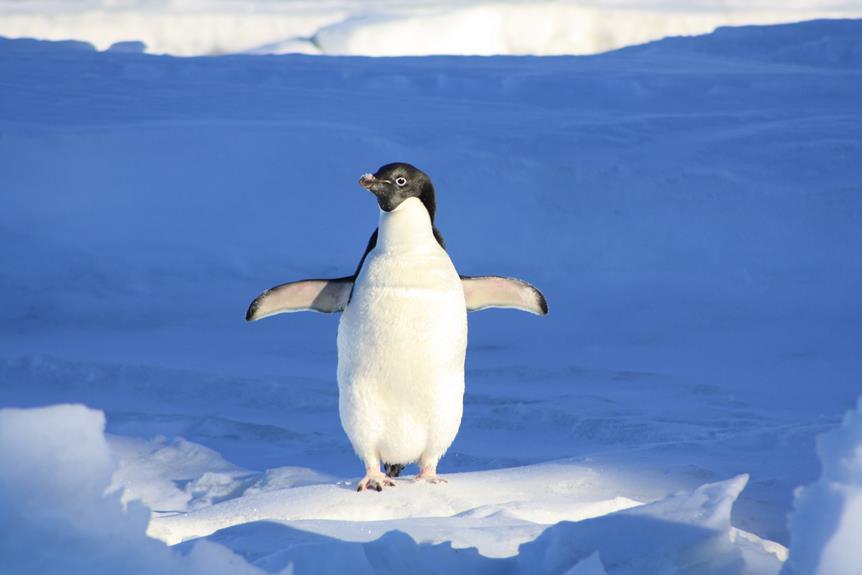Discover the enchanting world of black and white animals, where elegance and charm converge.
Like keys on a piano, these creatures create a visual symphony, captivating our imagination.
From the graceful zebra to the adorable panda and the classic charm of the Dalmatian, their distinctive coloration has long fascinated us.
Immerse yourself in a captivating trivia experience with a game developed by TapNation, offering comprehensive answers and tricky questions that will expand your knowledge and appreciation for these captivating creatures.
Download this free game and embark on a journey into the remarkable realm of black and white animals.
Key Takeaways
- Black and white animals such as zebras and pandas face threats from habitat loss and poaching.
- Conservation efforts for black and white animals include the establishment of protected areas and anti-poaching initiatives.
- Black and white animals like dalmatians and skunks have unique coat patterns and are depicted in popular culture and symbolism.
- Penguins and orcas (killer whales) have distinctive black and white coloring and face threats from habitat destruction, pollution, and overfishing. Conservation efforts for them involve reducing pollution and regulating whale watching.
Zebra
The zebra is known for its distinct black and white stripes. These unique stripes serve several purposes in the animal kingdom. Firstly, they act as a camouflage mechanism, helping zebras blend into their surroundings and making it difficult for predators to single them out. Additionally, the stripes may also serve as a way for zebras to recognize one another within their herds, as no two zebras have the exact same stripe pattern.
However, despite their iconic appearance, zebras face numerous conservation challenges. Habitat loss due to human activities, such as agriculture and urbanization, poses a significant threat to their natural habitats. In response, conservation efforts are being made to protect the zebra population and their ecosystems. Measures include establishing protected areas, implementing anti-poaching initiatives, and raising awareness about the importance of zebras in maintaining a balanced ecosystem.
These efforts are crucial in ensuring the survival of these magnificent animals for future generations.
Panda
Continuing the exploration of black and white animals, the subtopic of 'Panda' introduces us to a beloved species known for its iconic appearance and endangered status. Pandas are native to China and are recognized worldwide for their distinctive black and white fur.
Due to habitat destruction and poaching, pandas are classified as vulnerable by the International Union for Conservation of Nature (IUCN). Conservation efforts have been implemented to protect and preserve their natural habitat, including the establishment of national parks and reserves. These efforts aim to ensure the survival of pandas and maintain the biodiversity of their ecosystems.
In Chinese culture, pandas hold great symbolism and are considered a national treasure. They are often depicted in art and folklore, representing peace, harmony, and good fortune. Their cultural significance further emphasizes the need for their conservation and protection.
Dalmatian
With its distinctive black and white coat, the Dalmatian is another iconic and beloved black and white animal, adding to the exploration of this unique color combination. Dalmatians are known for their striking appearance and are easily distinguishable from other black and white animals. Here are some of the characteristics that set Dalmatians apart:
- Dalmatians have a short, dense coat with spots that can be black or liver-colored.
- They are medium-sized dogs with a muscular build and a sleek, athletic appearance.
- Dalmatians have a friendly and outgoing temperament, making them great family pets.
- They are known for their high energy levels and require plenty of exercise and mental stimulation.
In popular culture, Dalmatians are often portrayed as loyal, playful, and courageous. They became famous through movies like '101 Dalmatians,' where they were depicted as intelligent and protective. Their distinctive coat has made them a popular choice for firehouse mascots and in the fashion industry for their unique and eye-catching look.
Penguin
Moving on to the next black and white animal, we delve into the world of penguins. These adorable creatures are known for their distinctive black and white plumage, but there is much more to them than meets the eye.
One fascinating aspect of penguins is how they stay warm in their icy habitats. They have a unique adaptation called counter-current heat exchange, where warm blood from their core heats up the cold blood returning from their extremities. This helps them conserve heat and maintain their body temperature.
There are several interesting facts about the different species of penguins. For example, the Emperor Penguin is the largest of all penguin species, standing at an impressive height of up to 4 feet. On the other hand, the Little Blue Penguin is the smallest, reaching only about 13 inches in height. Additionally, the Gentoo Penguin is known for its impressive swimming abilities, reaching speeds of up to 22 miles per hour.
Penguins truly are fascinating creatures, perfectly adapted to thrive in their icy habitats.
Orca
Rarely seen in black and white, the majestic Orca captivates with its striking appearance and powerful presence. These intelligent creatures, also known as killer whales, are known for their distinct black and white coloring, which holds symbolic meaning in both nature and culture. Here are some key points about orcas and their conservation efforts:
- The symbolism of black and white in nature and culture:
- Black and white represent the contrasting forces of yin and yang, symbolizing balance and harmony.
- In nature, the orca's black back and white belly serve as camouflage, making it difficult for prey to spot them from above or below.
- In indigenous cultures, orcas are revered as powerful and wise beings, often associated with protection and transformation.
Conservation efforts for orcas and their habitat:
- Due to habitat destruction, pollution, and overfishing, orcas are facing significant threats to their survival.
- Organizations and researchers work tirelessly to protect and conserve orcas and their ecosystems.
- Conservation measures include efforts to reduce pollution, establish marine protected areas, and regulate whale watching activities.
- Public awareness campaigns aim to educate and engage communities in the conservation of these magnificent creatures.
Skunk
The skunk, a black and white animal, is known for its distinctive odor and unique coloration. Coloration plays a vital role in animal adaptation and camouflage. Skunks have black fur with white stripes, which helps them blend into their surroundings and avoid predators.
This color pattern serves as a form of warning to potential threats, as skunks possess a powerful scent gland that can release a noxious spray. Skunks have also made an impact in popular culture and symbolism. They are often depicted as mischievous or cunning characters in cartoons and literature.
The black and white coloration of skunks has become synonymous with warning signs and cautionary symbols, further highlighting their role as distinctive animals in both the animal kingdom and human imagination.
Magpie
Continuing the discussion of black and white animals, the magpie is a distinctive bird known for its monochrome plumage. This elegant creature holds symbolic significance in various cultures around the world. Here are some key points about the symbolism of black and white in animals:
- Contrast: The black and white colors of a magpie create a striking contrast, representing the duality of life and the balance between light and dark.
- Mystery: The bird's black and white feathers evoke a sense of mystery and intrigue, often associated with magic and superstition.
- Intelligence: Magpies are highly intelligent birds, and their black and white plumage symbolizes wisdom and cleverness.
- Adaptation: Black and white animals, like the magpie, have adapted to their natural habitats by using their contrasting colors for camouflage, communication, and mate selection.
Black and White Colobus Monkey
The Black and White Colobus Monkey is a distinctive primate known for its contrasting colors and unique characteristics. These monkeys can be found in the forests of Central and East Africa, where they inhabit a range of habitats including tropical rainforests, montane forests, and gallery forests.
They are known for their arboreal nature, spending most of their time in trees, where they feed on leaves, fruits, and flowers. Black and White Colobus Monkeys are highly social animals, living in large groups called troops, which can consist of up to 50 individuals.
Conservation efforts for these monkeys focus on protecting their natural habitats, as deforestation and habitat loss pose significant threats to their survival. Efforts also include raising awareness about the importance of conservation and implementing sustainable practices in the areas where they reside.
Arctic Fox
An example of a black and white animal is the Arctic Fox. This fascinating creature has adapted remarkably to its harsh environment in the Arctic. Here are some ways the Arctic Fox adapts to survive:
- Thick fur: The Arctic Fox has a dense and insulating coat that helps it withstand freezing temperatures. Its fur changes color with the seasons, turning white in winter for camouflage and brown in summer for better blending with its surroundings.
- Compact body: With a small size and short legs, the Arctic Fox conserves heat by minimizing its surface area exposed to the cold.
- Excellent hearing: The fox's sharp hearing allows it to locate prey beneath the snow, such as lemmings, which form a significant part of its diet.
- Dens: Arctic Foxes dig complex underground dens that provide shelter from extreme weather conditions and predators.
Conservation efforts are in place to protect the Arctic Fox population. These include establishing protected areas, monitoring their population size, and promoting responsible tourism to minimize disturbance to their habitats.







